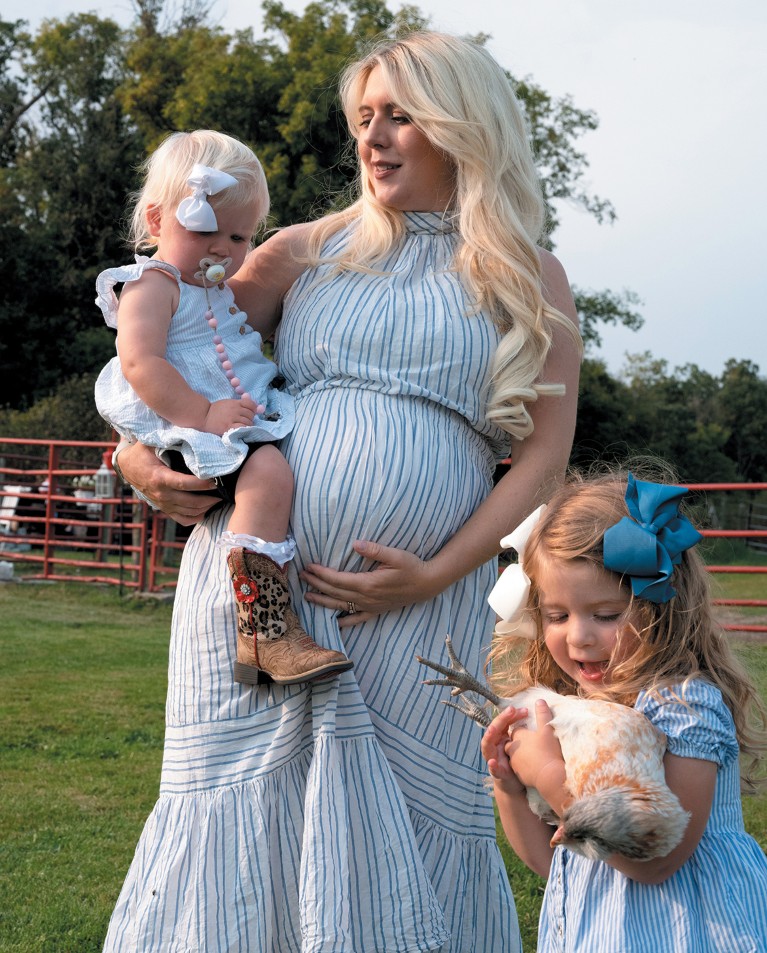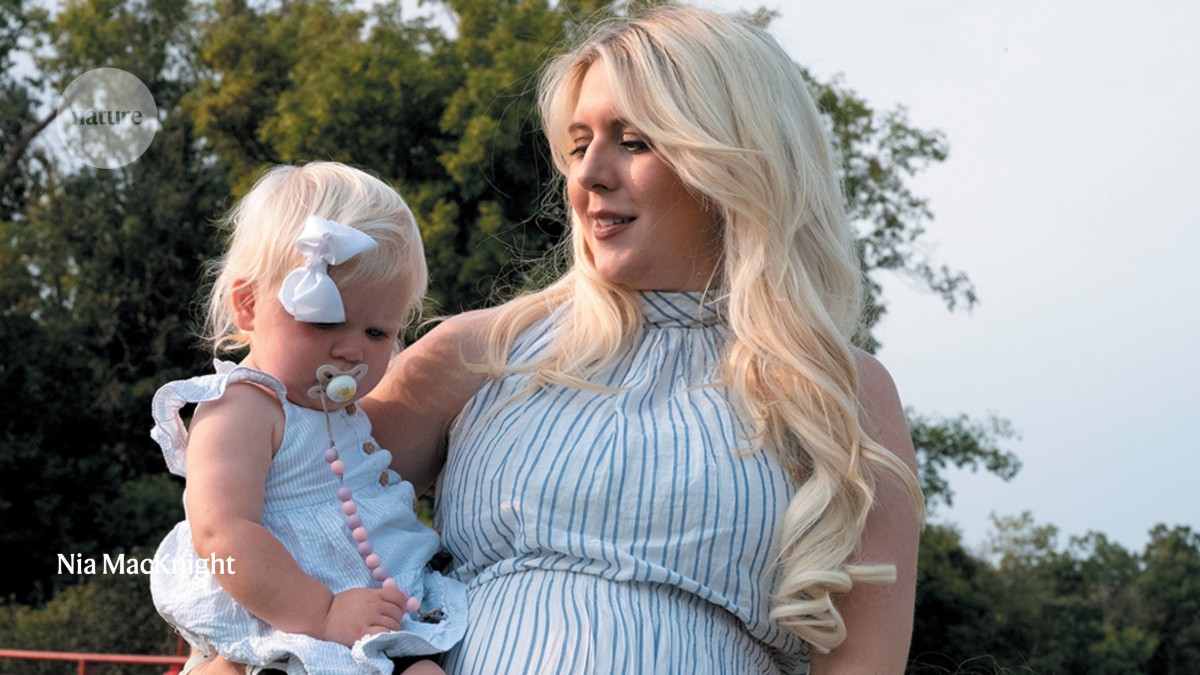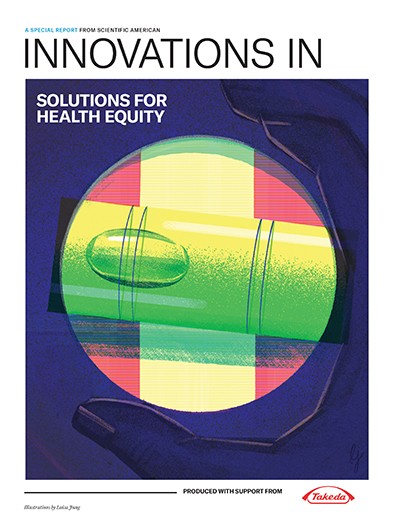
For Eliza Scott, who lives on a farm 2.5 hours away from the Bemidji clinic in rural Minnesota, virtual prenatal care with a clinic-provided home-monitoring kit has meant the difference between getting care or no care at all.Credit: Nīa MacKnight
On a frigid winter evening about five years ago, a desperately ill young woman walked through the doors of the Sanford Bemidji Medical Center in rural Minnesota. Several weeks before, she had labored alone for hours in her tiny mobile home to bring a new baby into the world. The woman had received no prenatal care and no medical attention at delivery—the kind of situation that has made maternal mortality rates for Native American women in rural areas twice as high as those of white women. The only reason she was showing up now was that the baby wasn’t eating. She had no running water to make formula. The hospital was her only option. Johnna Nynas, the obstetrician on call, quickly diagnosed her patient with postpartum preeclampsia, a rare condition that affects people after pregnancy and can be deadly if untreated.
For Nynas’s pregnant patients, the hospital in Bemidji is the only option between Duluth, Minn. (three hours away), and Fargo, N.D. (2.5 hours away). The surrounding area is one of the poorest in Minnesota. Some residents of the nearby Leech Lake, Red Lake and White Earth Indian Reservations don’t have reliable access to running water. With so many pressing unmet needs, people find it difficult to get prenatal care. Transportation (especially in winter) and child care for medical visits that require a several-hour car ride and possibly an overnight hotel stay are often unaffordable, even if Medicaid covers the cost of the health care. Nynas, who was born and raised in rural Minnesota, says that by the time an expectant parent arrives in her office, they may have a list of health concerns that have gone untreated for years. She links this lack of care directly to the elevated risk of pregnancy-related deaths and complications in the region.
“When we first meet patients, it’s probably the first contact they’ve had with the health-care system in quite some time,” Nynas says. Haunted by her patient’s preeclampsia emergency, she set out to remove barriers to needed care. Loaned blood pressure cuffs and bathroom scales let many of her low-risk patients receive checkups over the phone. This communication made it easier to schedule in-person visits for ultrasounds and blood tests.
Innovations In Solutions For Health Equity
David Driscoll, director of the Healthy Appalachia Institute at the University of Virginia, isn’t surprised that the impetus for change began in a rural area. The regions that face staggering health inequalities are developing innovative solutions to enhance well-being for everyone. Rural communities’ perpetual need to do more with less and to overcome obstacles not found elsewhere has led to modernized care delivery. Although many of the innovations are tech-centric, not all require Internet access to work. These shifts are helping doctors bring world-class medical care to even the most far-flung patients.
One challenge for rural health experts is to ensure solutions don’t exacerbate existing disparities. Doctor visits via a video call won’t help someone without an adequate Internet connection, for example. But advocates say thoughtful action paired with infrastructure investment will broaden access to services.
Simple equipment sent home with low-risk pregnant patients helped Nynas’s northern Minnesota families deliver healthy infants. Nynas’s success with home devices such as bathroom scales, blood pressure cuffs and fetal heart-rate monitors convinced her to expand her reach. Collaborating with several local community groups, Nynas applied for a grant from the federal government’s Rural Maternity and Obstetric Management Strategies program. With this funding, Nynas was able to not only expand patients’ virtual care but also provide additional local resources, such as an in-hospital food pantry, transportation services and a visiting-nurses program. She is setting up a satellite clinic at an Indian Health Service facility, which typically has limited prenatal services. This approach will let patients without home Internet or phones upload their data and connect with nearby providers in consultation with remote experts for complex pregnancies.
Health-care micro sites such as these act as a bridge between major medical centers and small communities and are showing huge promise in rural health, says Michael Carney, interim provost at the University of Wisconsin–Eau Claire, because they combine the best of telemedicine and in-person care. Patients without broadband Internet can go to a local clinic and talk to a specialist online. Nurses and other providers at the local clinic can do bloodwork, measure vital signs and nurture the doctor-patient relationship. These micro sites are the flagship of the University of Wisconsin’s ongoing rural health partnership with the Mayo Clinic, Carney says, and are intended to bolster the health of his hometown. Carney says practitioners worldwide are asking, “How do we deliver health care in a cost-effective way to people who can’t come to a traditional clinic?”
In southwestern Virginia, where Driscoll grew up, the distances between two points aren’t that far as the crow flies. But the residents of the area’s tiny towns and hollers aren’t crows. The narrow, winding roads mean even seemingly short drives can take hours. Without public transportation, many of the area’s older adults can’t travel to medical appointments. Driscoll’s first job, in the 1990s, was with a community organization that drove local patients to clinics and hospitals.
Driscoll chatted with his passengers, listening to their problems. Many said the doctor’s visit they were headed to was their first in years because they had been physically unable to get to appointments. Multiple, untreated chronic diseases such as asthma, diabetes and hypertension were the rule, not the exception. With poverty rates high and grocery stores few and far between, most of his passengers experienced food insecurity, and their diets lacked fresh fruits and vegetables. The few people who had home Internet relied on dial-up because broadband wasn’t available yet.
Rural communities in Virginia and around the world face many of the same challenges—lack of clean drinking water, unreliable transportation, lagging investments in infrastructure and technology, and hospital and clinic closures. Driscoll’s conversations revealed precisely how those challenges contribute to health disparities. It sparked his lifelong interest in rural health and ultimately brought him back home to the rugged hills where Virginia disappears into Tennessee and Kentucky.
Today, with a $5.1-million federal grant, Driscoll is addressing problems that have been amplified by the COVID pandemic. According to one study, so-called diseases of despair, including opiate misuse and overdose, suicide and alcohol-related liver disease, spiked by 40 percent in central Appalachia during the beginning of the pandemic. As a result, the number of premature deaths in Appalachia is 25 percent higher than in the rest of the U.S.
Like many rural health programs, the efforts at the University of Virginia rely extensively on telehealth. That’s largely because in the mid-1980s, awareness of these kinds of health disparities (and their origins) dovetailed with emerging technological breakthroughs. As a policy analyst at the Virginia Department of Health, Kathy Wibberly was tasked with helping to address deficits in health-care access in rural parts of the state. One of the solutions that emerged was the potential for telemedicine. Many of the region’s small, rural hospitals didn’t have the patient volume to warrant hiring, say, a neurologist or a neonatologist. Very sick newborns or people experiencing a potential stroke would have to be sent by ambulance or helicopter to a large medical center, often hours away. Such delays in care can prove deadly. “With stroke, time is precious. You’re saving the brain,” Wibberly says.
Instead of moving patients, Wibberly began working to connect small hospitals with their large, urban counterparts via videoconferencing and other technologies. Rural physicians could consult with on-call specialists in distant parts of the state to stabilize or manage fragile patients. This approach, she says, “saved lives and saved brains and saved disability further down the road.” In 2019 more than one quarter of U.S. hospitals had the capacity for telehealth-based stroke care.
After some initial success, Wibberly began trying to expand telehealth access. Her biggest problem, however, wasn’t related to technology. It was convincing patients, insurers and especially physicians that the approach could work. Few doctors have received telemedicine training during their residencies and internships, then or now, Wibberly says. They learn to see patients in person—that’s the model they’re trained with and used to.
“Yet at the same time, the landscape has changed,” Wibberly says. Medicine is no longer strictly an in-office practice. COVID accelerated the adoption and acceptance of telemedicine, and it has become a mainstay of rural health care, she says, especially in behavioral health care and psychiatry.
Telehealth alone can’t fix all the health problems facing rural areas. Limited broadband access means not everyone can set up a video chat with their doctor. And a lot of medical care requires in-person visits and readily available providers—things that aren’t guaranteed as rural hospitals continue to shrink or close. To tackle these issues, providers have gotten creative.
A diagnosis of kidney failure is life-altering. For residents of the remote Australian outback, it can be doubly so. The Pintubi people returned to Kintore, around 500 kilometers west of Alice Springs in the Northern Territory, in the 1980s after forced displacement by the Australian government starting in the 1940s. Those who needed dialysis had to leave again to receive care at the nearest clinics in Alice Springs or Darwin. Indigenous peoples such as the Pintubi make up almost 4 percent of Australia’s population and more than 14 percent of people on dialysis in the country. In 2016 research showed that Aboriginal people’s kidneys reached end-stage failure decades sooner than the kidneys of non-Indigenous Australians and New Zealanders, and an earlier study had found they were 1.5 times more likely to die on dialysis. For those who survived, quality of life was low.
Aboriginal Australians wanted to be “on country”—to live in their ancestral homelands with loved ones—while on dialysis. When the Australian government rebuffed their requests, Indigenous artists auctioned their work to raise more than $1 million (AUD) to build a nonprofit dialysis clinic, Purple House, in Kintore.
But bringing dialysis to an area where sheep overwhelmingly outnumbered people wasn’t an easy proposal. What’s more, dialysis is a thirsty procedure, using hundreds of liters of water for a single week’s treatment. Such a water-intensive therapy is ill-suited to the outback, which contains some of the driest biomes in the world. Purple House CEO Sarah Brown, who was tapped to lead the organization after a long career as a bush nurse, needed a therapy she could bring to her patients that merely sipped from the region’s scarce water supply.
To make matters worse, what limited water does exist in the area’s deep wells has too much fluoride and other contaminants to be drinkable, let alone used in dialysis. To address the problem, a team of engineers developed a way to filter the water so it could be used for dialysis. Then, rather than discarding it, the clinic devised a setup that let it reuse the water to provide pressure for the system. Brown knew they also needed to work with community leaders to integrate traditional Aboriginal beliefs and healing into dialysis treatments.
Over the next 20 years the Purple House transformed dialysis in Australia. In recognition of its efforts, the government created a special billing code to allow more nurses to deliver dialysis in remote communities. “We have gone from the worst survival rates in the country to the best,” Brown says.
Brown’s group also built a traveling dialysis bus known as the Purple Truck. The bus visits communities not served by the clinics and allows residents of Alice Springs and Darwin to visit family. Both survival and quality of life have improved. Now densely populated regions such as Sydney and Melbourne have built their own dialysis buses. The approach not only brings access to the life-saving therapy but allows Australians to travel without missing crucial dialysis sessions.
Brown remade dialysis from the ground up. “We’re disruptors,” she says. “You don’t have to assume that something is going to stay the same. You can work together, and you can change the system.”
A maternal mental health program has had a similar impact in parts of rural Pakistan. To address growing global mental health needs, Atif Rahman, a researcher at the University of Liverpool in England, has developed short-term interventions that can be delivered by peers and other nonspecialists. The idea, he says, is to bolster access to behavioral health care, especially where treatment is virtually nonexistent.
Many of Rahman’s efforts have focused on perinatal health in Pakistan, where he is originally from. His team trained rural community members there to deliver coaching sessions to decrease the mental health struggles of new moms. “It’s a powerful combination,” Rahman says. “We are freeing the peer to be more of a human support.”
With a worldwide shortage of mental health workers, especially in the Global South, being able to rely on nonprofessionals opens doors to those most in need. Rahman says the community members in his program “are doing as good a job as trained therapists who spend years and years training.” He is now expanding the perinatal mental health program to parts of other low- and middle-income countries.
Not all these experiments in rural health will prove successful or be transferable to other communities, says Lauren Eberly of the University of Pennsylvania, a cardiologist who developed a phone-based treatment program for people with heart failure who live in the Navajo Nation. Different rural communities have different needs and barriers, she says, and scientists must gain local input and insight to determine what help people need and what they will accept. Researchers have to start by asking questions and listening to feedback rather than assuming they know how to solve long-standing, deep-seated problems, Eberly says.
“The traditional health-care system really benefits those who are fluent and those who are white. It’s really marginalized a lot of other groups,” Eberly says. “We really need to rethink how we can deliver health care in a way that makes sense for our communities and our patients.” The point, she says, is to use successful interventions as creative inspiration for solving other issues in health care and health equity.
Transportation issues aren’t limited to rural settings; they can affect urban areas, too. So can lack of broadband access, food insecurity, and other disparities. Because many innovations developed in rural areas target these broad problems, urban and suburban areas can also benefit from them. Telehealth is a prime example, Wibberly says. The advantages of telemedicine first appeared most obvious for rural areas, but the approach has gone mainstream. She is confident that other rural health programs will become standard medical practice.
To Wibberly, the reason so much innovation occurs in rural health is simple. “It’s a smaller community. People know one another. They know who the trusted entities are,” she says. “Let them figure out what will work for them because it’s a whole lot easier to fix access to care issues for a city of 20,000 than it is for one of 20 million.”



